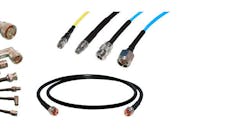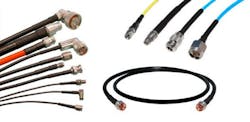Measurement systems for RF/microwave testing can assume mammoth proportions, what with sophisticated signal sources and costly vector network analyzers (VNAs) running under computer control and software in an equipment rack. But ironically, it is often one of the most inexpensive parts of the test setup that has the greatest impact on the accuracy of the final measurement results. Coaxial cable assemblies are often required for transferring signals to and from a device under test (DUT), but their importance is often overlooked when assembling a test setup.
Ideally, test cables should electrically “disappear” during a calibration. Regardless of the length and type of coaxial connectors, a test cable assembly exhibits a set of electrical characteristics, such as insertion loss, return loss, and electrical length (in phase). Modern test equipment with digital memories allow “with and without” measurements of coaxial cable assemblies with a suitable test fixture, so that the electrical contributions of a coaxial cable assembly (and the test fixture) can be subtracted from the overall test setup during a calibration. This ensures that the loss of a filter (if that is the DUT) is being measured, and not the loss of the filter and test cable.
Coaxial cable assemblies will exhibit different loss behavior under certain conditions, with ambient temperature affecting the insertion and return loss of a cable. In most cases, test equipment will be used in an industrial setting, typically under “room temperature” conditions (close to +25°C). This ensures that a cable assembly’s loss characteristics remains stable under stable temperature conditions, and that a calibration performed under stable temperature conditions to separate the loss of a connecting cable assembly from a test setup can be considered valid—assuming that subsequent measurements are also performed at temperatures close to those at which the calibration was performed.
But for any measurement systems employing cable assemblies and operated under environmental conditions where deviations in ambient temperature of more than ±5°C occur, it is judicious to measure or calibrate the electrical contributions of the cable assembly at various temperatures within the deviation range. Doing so provides a better understanding of the amount of loss or phase shifts that are being contributed by the cable assemblies in that test setup.
Selection of cables and connectors or complete cable assemblies for test and measurement purposes is often dictated by the requirements of a measurement. Semirigid cables offer excellent electrical characteristics but in a fixed shape that may mean sacrificing some ease of connecting a DUT to the test setup.
Flexible cables suffer higher insertion loss per unit length than semirigid cables, notably at higher frequencies (about 18 GHz), but provide fairly simply connections to a DUT since the cable assembly can be flexed. In between, hand-formable cable assemblies exhibit fairly low loss, with reasonable ease of connection to a DUT.
The number of measurements to be performed by a test system may also play a part in the selection of a test cable assembly: Durability may be an important requirement, and it is a characteristic that can vary widely across different commercial coaxial cable assemblies. For example, cable assemblies formed with cables using solid cable center conductors tend to wear out with a smaller number of flexures than cable assemblies constructed using cables with stranded cable center conductors. A test application, such as production testing versus R&D testing, will establish the type of test procedures for a cable assembly regarding the number of measurements and flexure that a cable assembly must undergo.
Coaxial cable assemblies suitable for test and measurement purposes are available from a large number of dependable RF/microwave suppliers, including several firms well known as sources of different types of high-frequency components, such as L-com, Mini-Circuits, Pasternack, RF Industries, and Times Microwave Systems. In fact, the number of suppliers continues to grow, as Anatech Electronics recently introduced its product families of coaxial RF/microwave cable assemblies.
If anything, coaxial cable assemblies are growing in importance as test system components. As additional system-level performance parameters, such as passive intermodulation (PIM) must be determined from measurements, cables must be specified with performance levels that make it possible to measure the different characteristics of a DUT. And the importance of those cable assemblies should never be overlooked as part of a test system.

